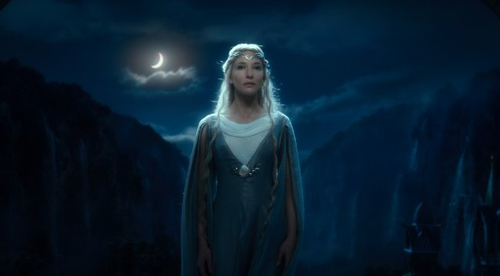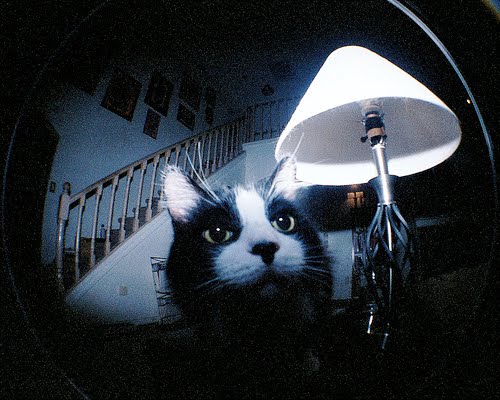Time and again folks have recommended Dwight V. Swain's books on writing to me but I put off reading his work. I told myself I didn't have time. Well, the past week as I've waited impatiently for my arm to heal I've had the time!
Yep, that's called hunting for a silver lining. But I have to say: Wow! What a lining. I wish I had discovered Mr. Swain's work years ago. His advice (I listened to his
Master Writing Teacher CDs) is specific and concrete; it's the sort of thing that I feel will give me an immediate payoff in my own writing.
Today I'll talk a bit about what Mr. Swain has to say about how to build a story (the first 2 CDs) and tomorrow, or another day, I'll discuss his views on character development.
Casting Your Novel
Alfred Hitchcock once wrote, "First you decide what the characters are going to do then you provide them with enough characteristics to make it seem plausible that they should do it".
Writers are like gods; we set up ourr characters, decide what they need to do, then rationalize their behavior.
Cast for contrast: TAGS and TRAITS
Assign each of your main characters
tags and
traits and see to it that these tags and traits are different, each from the other.
Tags
Here are examples of tags:
- blond hair,
- long finger nails painted red to look like talons dipped in blood,
- a peg leg, etc.
Do not have three gorgeous blonds in the same story.
Do not have two characters with peg legs unless you have a
very good story driven reason.
Do not have all of your characters blue eyed or black eyed.
You get the idea.
Traits & Dominant Impressions
Dwight Swain suggests you give each of your characters different manners of dealing with the world so that the reader can tell one character from another. Specifically, give each character a different
dominant impression.
Impressions
An impression is made up of a NOUN OF VOCATION and an ADJECTIVE OF MANNER.
Noun of Vocation
Most of us are known according to our role, our vocation. For instance, we expect a carpenter will behave differently from a lawyer. A stay-at-home mom will behave differently than a longshoreman.
Mr. Swain holds that you need to give each of your (main) characters a vocation, a role in life; for example, carpenter, lawyer, stay-at-home parent, writer, and so on.
Adjective of Manner
Each of us behaves in a distinctive way. Most of the time it isn't anything we think about, it is automatic, habitual.
Dwight Swain admonishes us not to be subtle. Assign characters manners in such a way that your readers will be able to recognize that character instantly whenever they appear in your story.
Mr. Swain uses this example: Let's say a character's noun of vocation is "waitress" and her adjective of manner is "sloppy". The dominant impression would be "sloppy waitress". Once you know this, you know how she is going to behave. You have a picture of her you can write to.
Dominant Attitude
Assign each character a
dominant attitude. This is "a way of looking at life, a way of dealing with the world".
Here's an example of a dominant attitude:
Don't make waves. No matter what happens a character with this dominant attitude will manage to fade into the background. Why? Because they don't want to conflict with anyone. They deal with life by being self-effacing.
Here's another example:
Might makes right. This character feels they can get their way by pushing people around. This is his attitude toward the world, toward your other characters.
Character And Situation
Let's go back to the beginning for a moment. What is a story all about? What lies at its core? It's this:
A character wants to change his unacceptable situation, a situation he just can't stand.
What you need to do as a writer is figure out
why, objectively, this character wants to make this change. It will help us if we first know what kinds of things people want.
Things People Want
a) Possession of something
They want a girl, they want an alley cat, they want one million dollars. They want
something, it doesn't matter what.
b) Relief from something
They want relief from a boss the character doesn't like, from a wife the character can't stand, from a climate that gives your character the most hideous allergies.
c) Revenge for something
Someone has done something to your character and he wants to get back at them.
Your Character's Subjective Reasons For Acting
Dwight Swain feels that, often, the
subjective reasons for action are more important than the objective ones (for instance, he wants to win back the heart of the one he loves or he wants to find treasure, and so on).
a) We need to know what the character needs to feel happy.
This is likely going to be a little different for everyone. Some people need to have an active lifestyle filled with extreme sports to be happy while for others happiness is a good book and a warm fire. Tell us what
your character needs to be happy.
b) We need to have some insight into what the character is scared of.
For instance, is she scared of the villain? Of old age? That she will be convicted of a crime committed in the past? That she will lose someone she loves?
A character is
always scared of something and you need to know what that is, even though it may never happen.
c) What is your characters lifestyle?
Mr. Swain observes that most of us are impulse buyers in the supermarket of life. Most of us drift rather than go in a straight line. We think something is a good idea so we do it.
The 4 Wishes/Motives
When we talk about lifestyle there are 4 wishes that drive people. Know which of these is dominant in your character, as well as how they combine with others.
a) Adventure
The desire for new experience.
b) Security
A woman grew up dog poor on a farm. Now she's rich. But that need for a feeling of security is so important that she lives like she was still on that dirt farm.
c) Recognition
The drive to fame. This is the drive that Mr. Swain feels makes groupies. They want to associate themselves with something bigger than they are.
d) Response
Some folks crave being surrounded by people who demonstrate they think highly of you, that you are important to them.
Each of your main characters are going to have each of these desires to a certain extent. You need to decide what the
main thing is that drives them.
Why doesn't your character quit?
When the going gets tough why doesn't your character throw in the towel and walk away? Why doesn't she go home, crack open a tub of Rocky Road ice cream, climb into sweats, and watch her favorite TV programs?
Yes, there's going to be an external goal, something out there in the world she wants. For instance, winning over the one they love, gaining their freedom, finding a treasure, and so on. But perhaps the most important reason for not quitting are the subjective reasons. For instance, maintaining ones self image.
Self-Image
We all have a self-image, we all have an idea--or think we do--of what we'll do and what we won't do. Pride and shame shape this. We'll do things we're proud of and we will avoid doing things we are ashamed of.
What is the self-image of your main characters? What is that the that is so important they can't let go of it even though it makes no sense in terms of logic.
Alfred Hitchcock once wrote:
Audiences want to identify with a hero who wants to do something and eventually succeeds in doing it even though they don't necessarily, morally, endorse his actions.
Villain/Antagonist
The strength of your villain is the strength of your story.
The
key characteristic of villainy is RUTHLESSNESS. A villain is someone who wants something so much that they are perfectly willing to push other people around in order to get it.
For instance, the guy who wants the corner office with all the windows. He's willing to hurt others to get this.
Building Your Novel & Writing Your Novel
Dwight Swain notes that building a novel is a bit different than structuring your novel. When we talked about
structuring a novel we were discussing the broad, general, outlines of the story. When we talk about
building a novel we are talking about putting in item after item to make the whole thing make sense.
The Beginning
A good opening raises questions in your reader's mind. It carries the implied premise that something interesting is going to happen. That the first paragraph and those that follow have exciting
consequences.
Consequences
Whatever happens in a novel should have consequences. That's the way the world works, that's the way
we work. Whatever you start your book with is what is going to have this ripple effect, is going to send cause-and-effect ripples throughout your book, so you need something interesting to start everything off.
Mr. Swain writes that there are many ways to begin, but that he has found these to be the most effective: hooks and springboards
The Hook
The book is a "striking, self-explanatory scene that plunges some character into danger in a manner that intrigues readers".
Ordinarily it raises the fear that something will or won't happen. For example, the shark in
Jaws was a hook. It instantly established fear and tension.
The Springboard
In its simplest, bluntest, form it will open with "he" or "she" or the character's name, and then will follow with motivated action. That is, the character has a purpose, whether it's related to the overall story or not, as long as it puts the character in a position to be in danger. Not necessarily
in danger, but in a position where he
could be in danger.
For instance, you could have a character that was going to the post office to mail a package and something happens which puts him in a position to be in danger.
In other words we are allowed to build the character without a lot of melodrama in the beginning but the important thing is that, in the beginning, you either put your character in danger
or you put your character in a position where he
will be in danger.
The Middle
A strong beginning is important but tension and interest are things that you
capture and
recapture. You need to hold, and build, your readers interest throughout the novel.
You leapfrog from one exciting moment to the next. Remember: Drama is life with the boring bits left out.
"When in doubt, drop a corpse through the roof"
That pearl of wisdom is from Ray Palmer. And it doesn't just apply to horror stories, this is true for mainstream as well. Or, rather, the idea behind it.
In mainstream fiction you still have to hold your readers interest. Yes, you go about it in a different way--it's probably
not going to be raining corpses--but the essential idea is the same.
Chapters, Scenes & Sequels
You build your novel a step at a time and you build it in segments called
chapters. A chapter is made up of a succession of new developments, of changes, presented in an
interlocking series of SCENES and SEQUELS.
A scene is a time unified unit of conflict, of confrontation, and is made up of three elements:
a. Goal
b. Conflict (between two opposing forces)
c. Disaster
We use sequels to link scenes together.
Sequels have three parts:
a. Reaction
b. Dilemma
c. Decision
The function of a sequel is to give your story some logic, some plausibility and to enable you to get from one clash to the next.
For instance, you have a fight between two people. The fight is over and it ends on a note of disaster. This unanticipated development throws your character off. What is their reaction?
a. Reaction: Shock
b. Dilemma: What do I do now?
c. Decision. Eventually your character will reach a decision about what to do. This decision provides him with a GOAL, the purpose, the what-shall-I-do of the next scene.
This is your single most useful tool in putting together a story.
A scene is the place where you build the movement of your story and a sequel is a unit of transition that links two scenes.
Further, the proportion of SCENE to SEQUEL is what determines the pacing of your novel.
A scene puts emphasis on the struggle between your two forces, it builds action and excitement and speeds up your story.
A sequel gives you the logic and the believability of your story.
You will find, if you analyse books, that they are built of scenes and sequels. That's how you build a story.
(See also:
Making A Scene: Using Conflicts And Setbacks To Create Narrative Drive for a discussion of the idea of
Yes but .../No and ...)
Endings
Each time you introduce a new development--a complication--your characters situation changes. No state of affairs--no scene, no chapter--should end the same way it began.
Big Moments
Dwight Swain advises that writers devise three or four big moments for their story. Some highly dramatic scene disaster. A disaster is
any unanticipated development that changes the course of things.
Maybe your MC is broke and finds he inherits a million dollars. That's a disaster in the sense it changes his situation and forces him to look at things in a new light.
Plants
In order for a Big Moment to work out a writer will have to include a PLANT where a plant is something one includes in a story just so something else will work out.
The End
There are two parts to the end:
a) The climax
b) The resolution
The Climax
This is the showdown. The final clash between whatever threatens the main character's happiness and the main character.
You need a clash that will force your character into some kind of decision about what his immediate actions are going to be. You want something that will set your readers up and tell them how they should feel about your main character and whatever else is going on.
Here's Dwight V. Swain's advice on how to do this: Provide your character with an easy way out, but don't take it.
This easy 'solution' should provide the hero with a way to solve his problem--it will fix things--
but it will be morally unacceptable.
For instance, Ken (the MC) has money problems, he just needs to steal from the till at work--and he has a good scheme for doing it--and that will solve his problem.
But it would make your readers mad. Readers want a happy ending, they want to see the character in.
The Resolution
This is the wrap up, the pay off. Now you'll reward or punish your central character according to how he, or she, has behaved.
Mr. Swain notes that writers should keep in mind that books with moderately happy endings tend to sell best. Generally readers don't like a tragedy, although you would be able to get away with more if you were writing a horror than if you were writing, say, a romance. Readers tend to like to see the main character make the 'right' decision and be rewarded. But you're the writer so you're the god of the story and can do whatever you want. That's the bottom line. This is
your story.
In Conclusion
Wow! This has been a long post. There's more, but I think I'll break off for now. Tomorrow I'll pick up where I left off and talk about what Dwight V. Swain has to say about emotional clocks and testing your novel to make sure it's got all the right bits.
Other articles you might like:
-
Michael Hauge On How To Summarize Your Novel
-
How To Succeed As A Writer: The Value Of Failure
-
Six Things Writers Can Learn From Television
Photo credit: "
Ivy and Sweetiepie" by
thejbird under
Creative Commons Attribution 2.0.










